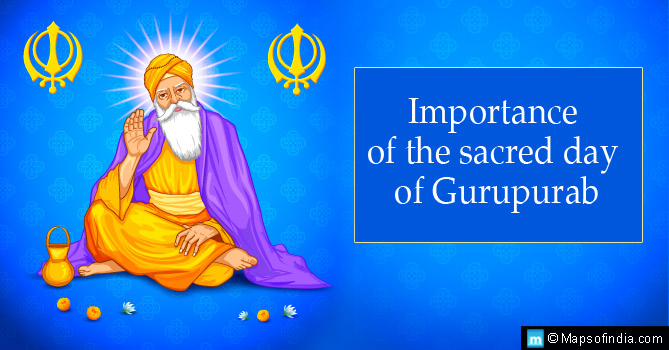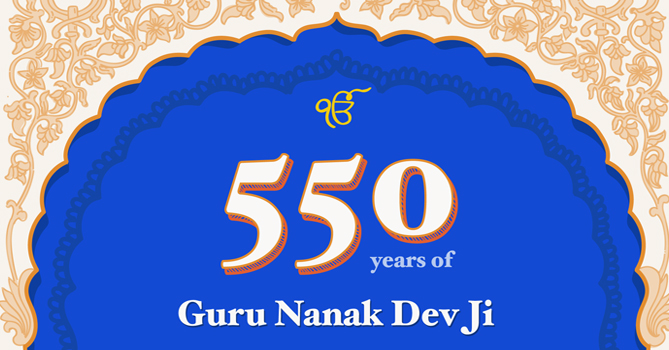The people belonging to the community of Sikhs all around the world will be celebrating Guru Nanak Jayanthi, known as Gurupurab, on November 08, 2022. Guru Nanak was the founder of the Sikh religion, and this Gurupurab commemorates the birth anniversary of the First Guru of the Sikh religion.
Gurupurab literally means the festival of remembrance of the Guru, and each of the 10 Gurupurab celebrated by the Sikhs in a year is associated with the lives of the 10 Gurus of this religion and honour the 10 Gurus of the Khalsa Pantha. Of the 10 Gurupurabs celebrated during the year, the four important ones include the birth celebrations of Guru Nanak and Guru Gobind, and the Martyrdom days of Guru Arjan Dev and Guru Tegh Bahadur.
Guru Nanak Jayanti: Prakash Utsav
Guru Nanak Jayanti falls during the month of Karthik as per Hindu Lunar calendar, and in the month of October/November as per the Georgian calendar. The founder of the Sikh religion, and the first of the ten Gurus, was born during Kartik Pooranmashi (Full Moon Day in Karthik), and is known to be one of the greatest religious innovators of all time.
Guru Nanak established a unique spiritual, social, and political platform based on equality, fraternal love, goodness, and virtue. Gurupurab celebrated in the honour of Guru Nanak is also known as the Prakash Utsav (the Festival of Light), for the people belonging to the community of Sikhs believe that Guru Nanak brought enlightenment to the world.
Guru Nanak’s words of wisdom, his doctrine, are recorded in the form of 974 poetic hymns in the holy scriptures of Sikhism, the Guru Granth Sahib. The Sikhs worship the Guru Granth Sahib, which includes the Japji Sahib, the Asa-di-Var and the Sidh-Ghost. The Sikhs believe that Guru Nanak bestowed upon the nine subsequent Gurus his spiritual sanctity, divinity and religious authority.
Celebrations
The Birth Celebration of Guru Nanak begins three weeks in advance.
- An early morning religious procession known as the Prabhat Pheri is taken out every day with the participants singing hymns (known as shabads) as they go around the different localities.
- Sweets and tea are offered to the participants by the devotees.
- Gurupurab celebrated on Karthik Puranmashi is the culmination of the Prabhat Pheris.
- The Guru Granth Sahib is read in the Gurudwaras without a break from the beginning to the end for three days. This is known as the Akhand Path and concludes on Gurupurab.
- A day before Gurupurab, the Guru Granth Sahib is also taken out in a procession in a palanquin (palki), escorted by 5 men depicting the Five Beloved Ones (Panj Pyare), carrying the Sikh Flags known as the Nishan Sahibs.
- Panj Pyare were the first to be baptised into Sikhism by Guru Gobind Singh at Anandpur Sahib on 30th March, 1699. They formed the nucleus of the Khalsa and were the first ones to receive the khanda ka phul (initiation in Khalsa).
- The Panj Pyare included Bhai Daya Singh Ji, Bhai Dharam Singh Ji, Bhai Himmat Singh Ji, Bhai Mokham Singh Ji, and Bhai Sahib Singh Ji.
- During the procession of the Guru Granth Sahib, the participants sing hymns and Gatka (Martial Arts) teams perform and showcase their swordsmanship.
- On Karthik Puranmashi, programmes start early in the morning with the singing of the morning hymns known as the Asa-di-Var followed by other hymns and exposition of the scripture called the Katha. There are also lectures and recitation of poems in the praise of the Guru.
- After the Ardaas (prayers), Karha Prasaad (sweetened porridge) is served to the devotees followed by community lunch known as Langar, where the rich and the poor sit together to partake it. Langars are unique to Sikhism and represent the essence of a religion that believes in the spirit of service (sewa) and devotion (bhakti).
- On this day, Sikhs all over the world celebrate the Gurupurab donning new clothes, visiting the Gurudwara and participating in sewa at the langar.
- Some Gurudwaras also hold night sessions of prayers and at about 1:20 a.m., the actual time of the birth of Guru Nanak, the congregation sings praises of the Guru and recites the Holy Word.
Guru Gobind Jayanthi
The Gurupurab celebrated in the remembrance of the 10th Guru of the Sikh religion generally falls in the month of December or January.
Guru Gobind Singh was the last of the 10 Gurus and forged the distinctive identity of the Sikhs and called them Khalsa (the pure). He introduced the baptising ceremony of the Khalsa (the warrior community) in Anandpur Sahib in 1699, wherein water and sugar are mixed in an iron bowl and stirred with a double-edged sword to prepare the Amrit (“nectar”).
This is then administered to the devotee, accompanied with recitations from the Adi Granth. This ceremony is known as khande ka phul. Guru Gobind made it mandatory for them to have the five Ks – Kesh (hair), Kripan (dagger), Kada (bracelet), Kangha (comb) and Kachcha (breeches).
Guru Gobind also announced a code of discipline for Khalsa warriors; and tobacco, eating meat slaughtered according to Muslim ritual and sex with Muslims were forbidden. The Khalsas also agreed to never interact with those who followed rivals or their successors. The co-initiation of men and women from different castes into the ranks of Khalsa also institutionalized the principle of equality in Sikhism regardless of one’s caste or gender.
The birth celebration of Guru Gobind is similar to Guru Nanak Jayanthi with Prabhat Pheris, Akhand Path and Langar.
The Martyrdom Anniversary of Guru Arjan
The Gurupurab in the remembrance of the martyrdom day of Guru Arjan, the fifth Guru of the Sikhs is also of great importance. This Gurupurab generally falls in May/June, the hottest months of summer in India. Guru Arjan was tortured to death by the orders of Mughal Emperor, Jahangir, at Lahore on 25 May, 1606. While the celebrations consist of kirtan, katha, lectures, karah prasaad and langar in the Gurdwara, the unique feature of the celebrations include the distribution of chilled sweetened milk to every passerby, regardless of their caste, creed or religious belief, by the devotees in the Gurudwaras and neighbourhoods. This gesture of giving relief to those tortured in the heat of the sun is symbolic of giving relief to the Guru who was tortured to death.
Martyrdom Anniversary of Guru Tegh Bahadur
Guru Tegh Bahadur was beheaded on 11 November, 1675 at Chandani Chowk, Delhi, by the orders of the Mughal Emperor, Aurangzeb, for refusing to convert to Islam. Gurupurab in memory of the martyrdom of Guru Tegh Bahadur is a one-day affair with Katha, Kirtan, Langar organised at the Gurudwara.
Other Important Festivals of the Sikhs
- Guru Gobind, the last living Guru of the Sikhs, conferred perpetual Gurudom on Guru Granth Sahib on 3rd October, 1708, three days before he gave up the material world. Known as Phalia Prakash Sri Guru Granth Sahib Ji, on this day Sikhs rededicate themselves to follow the teachings of the Gurus contained in the scriptures.
- Vaisakhi is another important festival of the Sikhs which marks the establishment of the Khalsa by Guru Gobind. Vaisakhi is generally celebrated on the 13th of April every year.
- The Sikh community celebrates Diwali in the form of Bandhi Chhor Diwas, which marks the return of the sixth Guru, Guru Hargobind to Amritsar, after his release from the Gwalior Jail. He had been imprisoned by Emperor Jehangir because of his growing popularity. Bandhi Chhor Diwas is celebrated just like Diwali with earthen lamps lit in houses and Gurudwaras.
- The martyrdom of the younger Sahibzadas of Guru Gobind Singh is observed every year in Fathegarh Sahib.
- The Battle of Chamkaur and the martyrdom of the elder Sahibzadas of Guru Gobind is also observed by the Sikh community.
- The Martyrdom of the 40 followers of Guru Gobind in Muktsar is observed with an annual fair known as the Mela Maghi, at Sri Muktsar Sahib.
Even though Sikhism has always propagated the message of Universal Brotherhood, they have had to face violence, torture at the hands of Mughal Emperors because of their growing popularity; and defend themselves in some of the most horrific battles, for the sake of defending a religion that they believed in. Today, it is no surprise that Sikhs have made it to the highest corridors of success and still remain unfettered in their approach towards the ‘have-nots’; they carry the message of peace and help the underprivileged as per the teachings of Guru Nanak Dev Ji.





